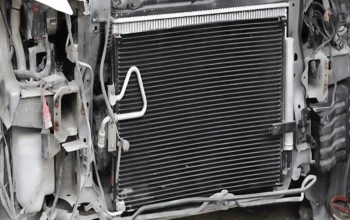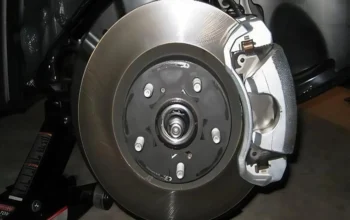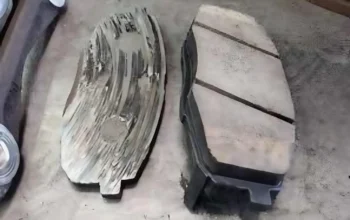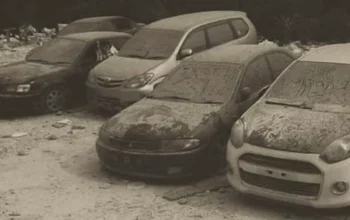Pena Global – Got a puddle of coolant under your car? Smelling something sweet after a long drive? You might be dealing with a radiator leak—and that’s not something you want to ignore. So, how much does it cost to fix a radiator leak in a car? The cost to fix a radiator can vary wildly, from under $100 to over $2,500 depending on the type of repair, your car, and even where you live.
Let’s break it down in simple terms. If it’s just a hose issue, you’re probably looking at a small repair cost. But if the radiator itself is cracked, buckle up—it could hit your wallet hard. In this guide, we’ll walk you through the price factors, repair options, and when it’s worth going DIY vs. calling a mechanic.
Table of Contents:
- 1. What Affects the Cost to Fix a Radiator?
- 2. Common Radiator Repairs and Their Costs
- 3. DIY vs. Professional Repair
- 4. Why You Should Fix a Radiator Leak ASAP
- 5. How to Lower Your Radiator Repair Cost
- 6. Signs of a Radiator Leak You Shouldn’t Ignore
- 7. Temporary Fixes You Can Try (But Shouldn’t Rely On)
- 8. Radiator Leak Prevention Tips
- 9. Are Radiator Repairs Covered by Warranty or Insurance?
- 10. When Is It Time to Replace the Entire Radiator?
- 11. FAQs: Fixing Radiator Leaks
- Final Recap: What Should You Do?
1. What Affects the Cost to Fix a Radiator?
There’s no one-size-fits-all when it comes to cooling system repair. Here are the biggest things that impact the total cost.
1. Location of the Leak
Not all leaks are equal. If the issue is with a radiator hose or a clamp, you might get away with spending under $100. But if the radiator itself is leaking, especially near the core, you’ll be looking at a much higher leak repair estimate.
2. Type of Vehicle
Your car matters—a lot. Fixing a radiator in a basic sedan is way cheaper than in a luxury SUV or a high-performance car. That’s because mechanic pricing and parts cost more for premium vehicles. Expect to pay more for both parts and labor.
3. Parts Quality (OEM vs. Aftermarket)
You can save a bit by choosing aftermarket parts, but they might not last as long. Original Equipment Manufacturer (OEM) parts are built to factory specs and tend to be more reliable—but they’re also more expensive.
4. Labor Costs
Where you live plays a huge role here. In bigger cities or coastal areas, hourly labor rates can be significantly higher. Also, if the repair is complex and time-consuming, the labor charges rack up quickly.
2. Common Radiator Repairs and Their Costs
Here’s what you can expect to pay for some typical radiator-related fixes. These are average estimates and may vary based on your car and location.
1. Coolant Thermostat Replacement: $212–$308
If your car is overheating or the cabin heater isn’t working, the thermostat might be the culprit. Replacing it is relatively straightforward and less expensive.
2. Lower Radiator Hose Replacement: $198–$295
A cracked or loose lower radiator hose can lead to leaks. Replacing it doesn’t take much time, but parts and labor still add up.
3. Upper Radiator Hose Replacement: $187–$285
Similar to the lower hose, the upper hose can wear out or crack over time. It’s a bit easier to replace but costs are similar.
4. Full Radiator Replacement: $710–$1,096
If your radiator is corroded, cracked, or beyond a patch job, you’ll need to replace the whole thing. This is the most expensive option but often the only long-term fix.
3. DIY vs. Professional Repair
Thinking about fixing it yourself to save money? That can work—but only if you know your way around the engine bay.
1. DIY Can Save Labor Costs
Labor makes up a big chunk of radiator leak repairs. If you do it yourself, especially something like a hose swap or thermostat change, you could save a few hundred bucks.
2. But It’s Not Easy
Replacing a radiator is a full-day job. You’ll need to drain and dispose of the coolant properly, remove a bunch of components, and install everything back correctly. If you mess up, it could lead to worse damage later.
3. Know When to Call a Mechanic
If you’re not confident or don’t have the tools, it’s worth paying a pro. A certified mechanic can diagnose other hidden issues in your cooling system, which might save you money long-term.
4. Why You Should Fix a Radiator Leak ASAP
Ignoring a radiator leak can lead to bigger issues—like engine overheating, warped cylinder heads, or even total engine failure.
1. Prevent Costlier Repairs
Fixing a small leak now is way cheaper than fixing a blown head gasket later. If you delay, a $200 repair could turn into a $2,000+ engine job.
2. Stay Safe on the Road
A sudden coolant dump while driving can cause your car to overheat fast. That’s dangerous and could leave you stranded, especially in summer heat or remote areas.
3. K-Seal’s Advice
Brands like K-Seal recommend treating radiator issues early—even if they seem minor. Sometimes, temporary sealants can buy you time, but they’re not long-term fixes.
5. How to Lower Your Radiator Repair Cost
Looking to cut down on expenses? Here are some smart tips:
1. Compare Mechanic Quotes
Always get at least two or three mechanic pricing estimates. Rates can vary a lot between shops, and some may charge more just based on location or reputation.
2. Use Aftermarket Parts (If Safe)
If your car isn’t too picky, you can save money with good-quality aftermarket parts. Just make sure they’re compatible with your car’s system.
3. Catch Problems Early
A small leak or crack is much easier—and cheaper—to fix than a big one. Keep an eye on your temperature gauge, check under your car regularly, and don’t ignore warning signs.
6. Signs of a Radiator Leak You Shouldn’t Ignore
Catching a radiator leak early can save you from a costly repair. Here are some clear signs your cooling system might be compromised:
1. Coolant on the Ground
One of the most obvious signs is a bright green, orange, or pink fluid under your vehicle. If you notice puddles or spots in your driveway, especially near the front of your car, it’s likely coolant.
2. Engine Overheating
An overheating engine is a big red flag. If your temperature gauge spikes, or you see steam from under the hood, stop driving immediately and get your cooling system checked.
3. Sweet Smell
Coolant has a distinct, sweet smell. If you catch a whiff of it while driving or after shutting the car off, you probably have a radiator leak somewhere.
4. Low Coolant Level
If you’re constantly topping off your coolant, there’s a leak somewhere in the system. Don’t just keep adding fluid—get the source identified and fixed.
7. Temporary Fixes You Can Try (But Shouldn’t Rely On)
Sometimes you need a quick solution to get back on the road, especially if you’re in the middle of nowhere. But keep in mind, these are short-term fixes, not long-term solutions.
1. Radiator Stop Leak Products
There are several products like K-Seal or Bars Leaks that can temporarily seal minor leaks. You pour it into your radiator or coolant reservoir, and it circulates to plug small gaps.
🟡 Warning: These products can clog up your radiator and reduce performance over time. Use only as a last resort.
2. Epoxy Patches or Hose Tape
For small hose leaks or cracks in plastic tanks, radiator epoxy or waterproof tape can provide a short-term seal. But again, this is not a permanent fix and should only be used until you get to a mechanic.
8. Radiator Leak Prevention Tips
Want to avoid a radiator repair altogether? Here’s how to keep your cooling system in top shape.
1. Regular Coolant Flushes
Old coolant breaks down and becomes acidic over time, which can eat away at seals and hoses. Flushing your coolant system every 2–3 years (or as recommended by your manufacturer) keeps the radiator clean and efficient.
2. Check Hoses and Clamps
Every few months, take a look under the hood. Squeeze the radiator hoses—if they feel brittle or spongy, it’s time for a replacement. Also, check clamps for rust or looseness.
3. Use the Right Coolant
Not all coolants are created equal. Always use the type recommended in your owner’s manual to avoid corrosion or clogging in the radiator and engine.
4. Don’t Ignore the Temperature Gauge
If your engine starts to run hot—even slightly—don’t just keep driving. Pull over and investigate. Minor issues become expensive fast if ignored.
9. Are Radiator Repairs Covered by Warranty or Insurance?
Wondering if you can avoid paying out of pocket? It depends on the situation.
1. Manufacturer Warranty
If your vehicle is still under warranty and the radiator failed due to a defect, the repair may be covered. But if the damage was caused by neglect (like lack of maintenance), it probably won’t be.
2. Extended Warranty
Some extended warranties or third-party service contracts cover radiator and cooling system repair. Check your policy details.
3. Insurance Coverage
Car insurance usually doesn’t cover wear-and-tear items like radiators. However, if the damage was caused by an accident or vandalism, comprehensive insurance might help.
10. When Is It Time to Replace the Entire Radiator?
Sometimes patching just doesn’t cut it. Here are signs that a full radiator replacement might be your best (and only) option:
1. Cracks or Corrosion
If the radiator is cracked, especially at the seams, or if it’s heavily corroded inside or outside, replacing it is the only safe choice.
2. Repeated Leaks
If you keep dealing with leaks in different spots, it’s a sign that the radiator is reaching the end of its life. Replacing the whole unit will be cheaper than constant repairs.
3. Overheating Despite Repairs
If your car keeps overheating even after replacing hoses or the thermostat, the core issue might be inside the radiator itself.
11. FAQs: Fixing Radiator Leaks
Here’s a quick rundown of common questions people ask when dealing with radiator problems.
Q: Can I drive with a radiator leak?
A: Technically yes—but it’s risky. Small leaks can become big ones quickly. If you must drive, keep coolant on hand and watch your temperature gauge closely.
Q: How long does a radiator repair take?
A: Hose or thermostat replacement might take 1–2 hours. A full radiator replacement can take up to 5 hours depending on your car model and mechanic availability.
Q: How long should a radiator last?
A: Most radiators last between 8–10 years, but that can vary based on climate, driving conditions, and maintenance habits.
Final Recap: What Should You Do?
If you’re asking how much to fix a radiator leak in a car, the answer comes down to what’s broken, what car you drive, and who’s doing the work. Here’s a quick cheat sheet:
- Small fixes (hoses, clamps, thermostat): $100–$300
- Radiator replacement: $700–$1,100
- High-end or luxury vehicles: $1,500–$2,500+
Bottom line: Don’t wait. Whether you DIY or go to a mechanic, dealing with a radiator leak early is always cheaper and safer than putting it off.






